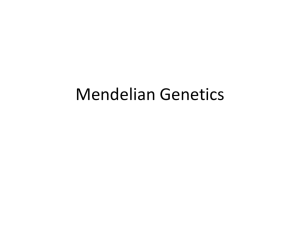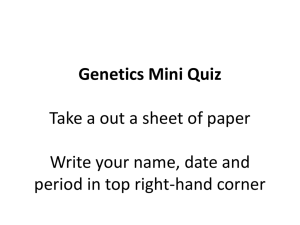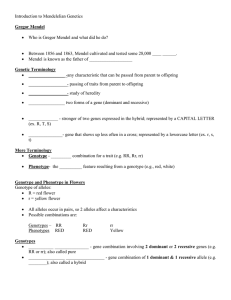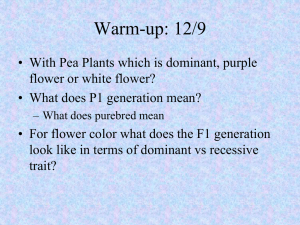Mendel and Genetics
advertisement
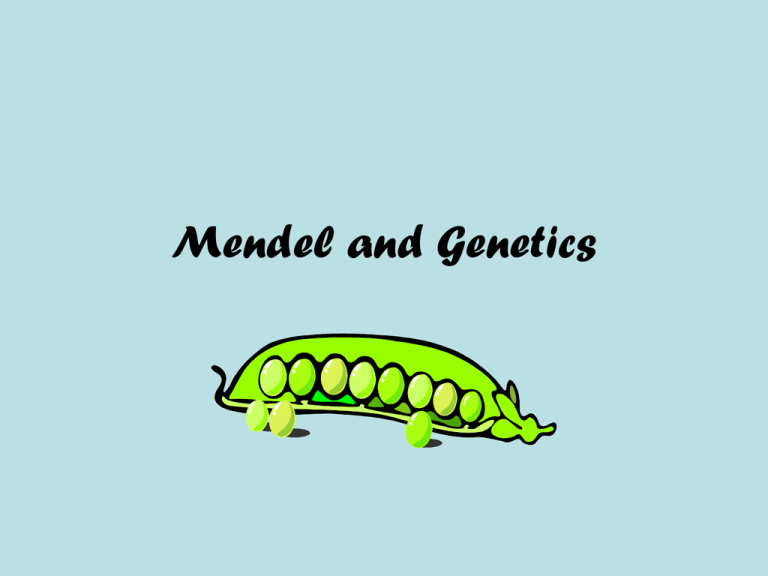
Mendel and Genetics • Gregor Mendel was the first scientist to study genetics and how traits are passed from parents to offspring (children.) • Mendel bred pea plants. He was able to see that some traits are passed down to offspring and sometimes they skip a generation. • Mendel studied pea plants because they have a great variety of traits, such as flower color, plant height, seed shape, seed color, pod shape, and flower position. • Pea plants are self pollinating, which means that they have both male and female reproductive parts. The pollen (male parts) from one plant can fertilize the eggs (female parts) from the same plant or another plant. • Mendel decided to breed one characteristic at a time. He used true-breeding plants to do so. True breeding plants will only produce their trait in their offspring. • Mendel also crossed two plants with opposite traits( for example, white flower with a purple flower). This is called cross-pollination. • He would take the pollen from one plant and sprinkle another plant that had the pollen removed. •Mendel conducted two experiments. • The first experiment involved cross pollination. • He found that one trait always showed up. He called this trait dominant. • The other trait seemed to disappear. He called this recessive • In the second experiment Mendel allowed each offspring plant from the first cross to self pollinate. • This time the recessive trait was also seen, not just the dominant! • The true-breeding cross is called the P or parental generation. • The offspring of a cross pollination are called the F1 generation. • The offspring from a F1 cross is called the F2 generation. • Mendel created a ratio of dominant to recessive traits to try to determine the reason for the results. • He realized that each parent donates genes to their children. The genes can be dominant, recessive (homozygous) or a mix of both (heterozygous. • The two forms of the genes are called alleles. • EXAMPLE: R= dominant gene for red r= recessive gene that appears white RR=homozygous dominant, red rr=homozygous recessive, white Rr=heterozygous, red • The actual letters that represent genes are called the genotype. • The physical appearance of those genes(example RED FLOWER) is called the PHENOTYPE. PHENOTYPES • To determine the outcome of a cross, you can use a punnett square. EXAMPLE: A homozygous dominant red flower crosses with a homozygous recessive flower, what are the genotype and phenotype of the offspring? R R r Rr Rr r Rr Rr • RR x rr • • GENOTYPE: 4 Rr PHENOTYPE:4 red flowers • B=black, b=white • REMEMBER: the dominant letter always goes first!!!! • EXAMPLE: 2 heterozygous black bunny crosses with one another. What are the genotype and phenotype of the offspring? • Bb x Bb Genotype=1BB,2Bb,1bb Phenotype=3 black and 1 white B b B BB Bb b Bb bb INCOMPLETE DOMINANCE Sometimes, there are two dominant alleles and no recessive alleles. Ex: flower color In some flowers, red and white are both dominant. A red flower has the phenotype ______ and the genotype RR. A white flower has the phenotype ______ and the genotype What if you cross a RED (RR) flower with a WHITE (WW) flower? R R W RW RW W RW RW What color are the offspring? R R W RW RW W RW RW WHIT E + RED PINK So, when a trait is inherited by incomplete dominance, there 3 are ____ possible phenotypes Red White Pink 3 possible genotypes. and ____ RR WW RW Multiple Alleles In some cases, there are more than 2 possibilities. Ex: hair color, eye color, skin color Blood Type • 2 Dominant alleles – A and B Genotype • 1 recessive allele – O AA AO AB BB BO OO Phenotyp e A A AB B B O What if you cross a AO parent with a BO parent? A O B AB BO O AO OO
